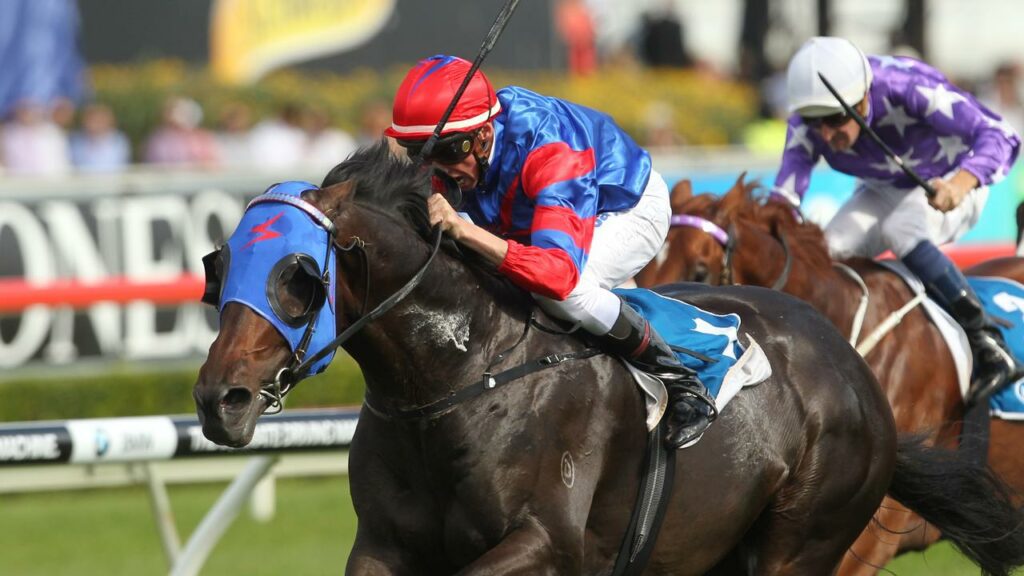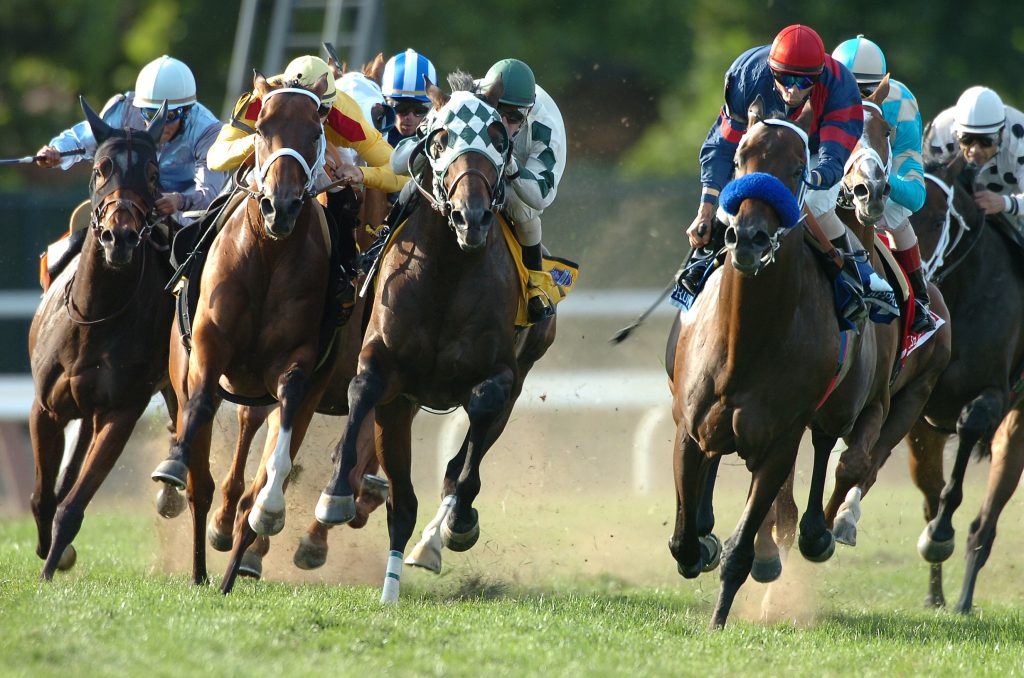Introduction
Blinkers In Horse Racing, one of the oldest and most popular sports in the world, has a long tradition of incorporating specialized gear and techniques to enhance equine performance. One such piece of equipment that often goes unnoticed by casual spectators is the “blinker.” While it may seem like a minor addition, blinkers can make a significant difference in how a horse performs during a race. These unique devices are not merely decorative; they serve a strategic purpose that trainers and jockeys leverage to improve a horse’s concentration and overall racing capability. Please visit this.
Understanding Blinkers: The Basics

Blinkers in horse racing are a type of hood or headgear that features side shields or cups next to the horse’s eyes. These side pieces restrict the horse’s peripheral vision, limiting distractions and helping the animal focus straight ahead. The main goal of blinkers is to prevent the horse from being distracted by other horses, crowds, or movements occurring to the side or behind them. Horses, by nature, have a wide field of vision, and while this can be advantageous in some scenarios, it may hinder their performance on the racetrack if they become anxious or unfocused due to external stimuli. Blinkers help mitigate these issues by narrowing the horse’s line of sight.
The Psychology Behind Using Blinkers
Horses are prey animals with a natural flight response, and their instincts cause them to constantly monitor their surroundings. This makes them prone to reacting to unexpected sights, especially in a high-energy environment like a racetrack. In many cases, horses without blinkers might veer off course, slow down, or lose focus if they become distracted by other horses or the cheering of the crowd. Blinkers help condition the horse to channel its energy forward rather than side-to-side. By reducing the stimuli from peripheral vision, the horse feels less anxious and more confident in its path, which can lead to improved performance.
Types Of Blinkers Used In Horse Racing
Blinkers In Horse Racing, There are several variations of blinkers, each designed to control a horse’s vision to different degrees. The most common type includes full-cup blinkers, which cover the entire side of the eye and block all peripheral vision. Semi-cup blinkers, on the other hand, offer a partial block, allowing a limited side view. There are also customized designs such as French cups, which extend further back for more restriction, and cheater cups, which offer the least restriction. Trainers choose the type based on the horse’s temperament and past performances. Some horses may need full-cup blinkers due to high sensitivity, while others benefit from a mild limitation with semi-cups.
The Role Of Trainers In Deciding Blinkers Usage
Trainers play a critical role in determining whether a horse should wear blinkers and, if so, what type. They closely monitor the horse during training sessions and look for signs of distraction, hesitancy, or lack of focus. If a horse shows potential but struggles to maintain concentration during gallops or drills, the trainer may introduce blinkers to see if performance improves. Blinkers In Horse Racing, The decision isn’t always immediate. It often involves a trial-and-error approach, and the horse’s comfort level is taken into serious consideration. A trainer’s experience, observational skills, and knowledge of the horse’s psychology heavily influence the final call.
How Blinkers Are Introduced To Horses?
Introducing blinkers to a horse is a gradual process that requires patience and careful conditioning. A sudden change in vision can be unsettling for the animal, so trainers start by fitting the horse with blinkers during regular training or schooling sessions. This helps the horse acclimate to the limited field of vision in a calm, familiar environment. Blinkers In Horse Racing, Over time, the horse learns that the blinkers are not a threat and that they do not impede its ability to run or respond to commands. Positive reinforcement, gentle handling, and consistency are essential to ensure the horse associates the blinkers with performance rather than punishment.
Blinkers In Official Races

Once a horse has been trained and accustomed to wearing blinkers, it may wear them during official races. In most racing jurisdictions, the use of blinkers must be declared before the race and noted in the race program. This transparency ensures that bettors and other participants are aware of any gear changes that might influence the horse’s behavior or performance. The notation “b” next to a horse’s name typically indicates the use of blinkers. In some cases, bettors may view the addition or removal of blinkers as a strategic move by the trainer and factor this into their wagering decisions.
Impact On Race Performance
Blinkers In Horse Racing can have a profound impact on a horse’s performance, especially if the animal previously struggled with focus or consistency. Horses wearing blinkers often show improved straight-line speed, better starts, and stronger finishes. They tend to stay on track more effectively, reduce weaving, and avoid becoming distracted by other horses during critical moments in a race. That said, blinkers are not a guaranteed solution. While many horses improve with blinkers, others may not respond positively or may even perform worse due to the stress of restricted vision. Every horse is unique, and the effectiveness of blinkers varies from one case to another.
Blinkers Vs. Other Vision-Controlling Gear
While blinkers are the most widely known visual aids used in racing, they are not the only ones. Another related piece of gear is the shadow roll, which is a fluffy noseband designed to block the horse’s view of the ground to prevent it from jumping shadows. There’s also the visor, a variation of blinkers with slits that allow limited peripheral vision. Hoods with earplugs are used to muffle sound, and some are used in combination with blinkers for highly sensitive horses. These variations are used depending on the horse’s specific needs and the conditions of the race.
The Controversy And Misconceptions Around Blinkers
Despite their widespread use, blinkers are sometimes misunderstood by the public and even some within the horse racing community. Some people view them as a way of forcing the horse to perform or as a crutch for poor training. In reality, Blinkers In Horse Racing, when used responsibly, blinkers are a humane and effective tool that can help horses perform at their best while feeling more comfortable and less stressed. The idea is not to blind or punish the horse but to create an environment in which it can thrive. Ethical trainers always ensure that the horse’s well-being comes first, and any use of blinkers is carefully monitored for adverse effects.
Success Stories: Horses That Excelled With Blinkers
There are numerous examples of champion racehorses that saw a dramatic uptick in performance after the introduction of blinkers. One of the most famous is Secretariat, who wore blinkers during his Triple Crown-winning run. Another is American Pharoah, whose blinkers helped him maintain laser-like focus during critical races. These stories highlight how blinkers can transform a good horse into a great one. Even in less high-profile races, trainers often recount how a previously unpredictable or anxious horse suddenly started winning races consistently after wearing blinkers.
Removing Blinkers: When It’s Time For A Change
Blinkers In Horse Racing, Just as blinkers can be added to improve a horse’s performance, they can also be removed if no longer beneficial. Over time, some horses grow more confident and less reactive to distractions, making blinkers unnecessary. In such cases, trainers might experiment with removing the blinkers to see how the horse responds. This can sometimes lead to an even better performance, especially if the horse feels freer and less restricted. The key is ongoing evaluation. Trainers must always be willing to adapt based on the horse’s changing behavior and maturity level.
Blinkers And Betting Strategy
From a betting perspective, the use of blinkers can offer valuable insights into a horse’s condition and the trainer’s strategy. Savvy bettors often pay close attention to gear changes listed in race programs. A horse that adds blinkers for the first time might be poised for a breakthrough, especially if it’s known to have been distracted in past races. Conversely, the removal of blinkers could signal a horse that has matured or undergone successful retraining. Bettors often analyze these changes alongside other factors like form, track conditions, and jockey performance to make informed decisions.
International Use And Regulation Of Blinkers
The use of blinkers is not restricted to a particular region and is common in racing cultures around the world. However, regulations may vary slightly depending on the country or racing authority. In the UK, for example, blinkers must be declared 45 minutes before the race, whereas in the U.S., such declarations might be made much earlier. Blinkers In Horse Racing, The materials and styles allowed may also differ, but the core purpose remains the same: enhancing focus and performance in horses. Global trainers often exchange insights and techniques related to blinkers, helping the practice evolve based on collective experience.
Blinkers In Other Equestrian Disciplines
While primarily associated with horse racing, blinkers are also used in other equestrian disciplines, such as driving and eventing. In driving competitions, blinkers help horses stay focused on the road ahead rather than reacting to the carriage or competitors beside them. In training environments, some equestrians use blinkers as a short-term aid for horses that struggle with distraction. However, the use in these disciplines is often more limited and temporary compared to the regular application in thoroughbred racing.
The Future Of Blinkers In Horse Racing

As horse racing continues to evolve with advances in technology and training methodologies, the use of blinkers remains a valuable tool. However, innovation is leading to more sophisticated designs that are lighter, more breathable, and more comfortable for the horse. Some trainers are even experimenting with transparent or semi-transparent materials that reduce distraction without entirely blocking vision. With increasing emphasis on animal welfare, the design and application of blinkers are being refined to ensure maximum benefit with minimal discomfort. The future of blinkers will likely be shaped by both tradition and innovation.
Conclusion
Blinkers in horse racing are more than just a piece of gear—they are a strategic tool deeply rooted in the understanding of equine psychology and behavior. Whether used to sharpen focus, reduce anxiety, or improve race-day performance, blinkers play a crucial role in shaping the outcomes of many races. From their basic function of limiting peripheral vision to their broader implications in training and betting strategy, blinkers have earned their place in the toolkit of modern horse racing. As long as horses continue to race, blinkers will continue to offer that subtle yet powerful edge that can turn a competitor into a champion.

